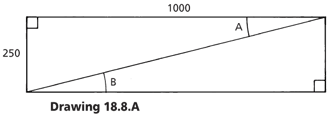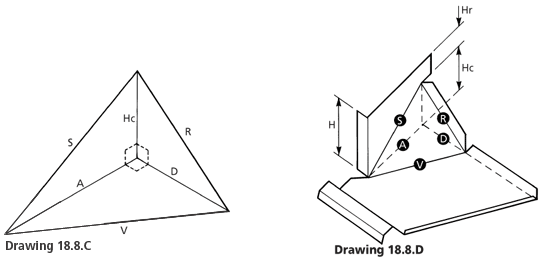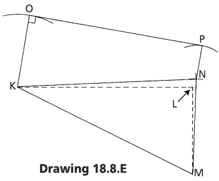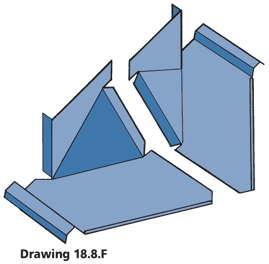When cricket and diverter penetration flashings are used, the pitch of the cricket valley will always be less than the pitch of the roof.
To find the pitch of a roof or valley, a simple method is to use a 1m long level measuring stick and measure the rise as shown in drawing 18.7A Measuring Stick Method. The relationship between the rise and the horizontal distance is known as the tangent of the angle and is calculated by using tan f = O/A (being the opposite side divided by the adjacent side). See 18.2 Pitch & Rise Calculator.
250/1000 = 0.25 = 14° (1 in 4)
N.B. Angles A and B are equal.
It is possible to obtain the length of the hypotenuse by using √ a2 + b2
Cricket flashings as described in section 6 can be made to suit any penetration width, any cricket flashing depth to width ratio and roof pitch down to 3°. For simplicity, three angles have been selected.
f X = 45°
f Y = 27°
f Z = 18°
Penetration Width = 2A
Depth = D
Valley = V
D = A
V = √2 = 1.42
D = 1/2A
V = √1.25 = 1.118
D = 1/3A
V = √1.11 = 1.054
To find the cricket valley pitch when the roof pitch is known, it is necessary to find the depth (D) of the cricket. If the depth of the cricket is half of the width of the penetration, as shown for 'Cricket X' the angles are at 45° and there is a defined relationship between the length of the valley of the cricket and the width of the penetration and also between the pitch of the valley of the cricket and the pitch of the roof.
This is 1 : √ 2 = 1.42, which means that to maintain the desired 3° fall in the cricket valley, the minimum roof pitch (4°) can be calculated using table 15.8.
If the depth of the cricket is a quarter or a sixth of the width of the penetration, there are also defined relationships between the pitch of the valley of the cricket and the pitch of the roof.
These are described in table 18.7C Relationships between the pitch of the valley of the cricket and the pitch of the roof as 'Cricket Y' and 'Cricket Z'.
All figures comply with the minimum fall of 1.5°, but all the bold figures will provide a 3° cricket valley pitch. This methodology is valid for all sizes of penetration. However, there is a point at which, having a design with a wide penetration and a low pitch, it becomes uneconomic to pursue the ideal 3° fall in the cricket valley. When the roof pitch is known, the minimum allowable fall of the cricket valley pitch (1.5°) can then be read from table 15.8.
It is permissible to lower the valley pitch because 1.5° allows sufficient fall to clear debris from the valley and therefore qualifies as a warrantable flashing.
A diverter flashing without a cricket design only shifts the position of the cricket to the top over-flashing of the penetration as shown on drawing 9.7.6B Cricket Flashings, unless the penetration is rotated 45° as shown on drawing 9.7.6C Diverter Flashings.
18.7C Relationships between the pitch of the valley of the cricket and the pitch of the roof
| ROOF PITCH | 3° | 4° | 5° | 6° | 7° | 8° | 9° | 10° |
| TANGENT | .0524 | .0699 | .0875 | .1051 | .1228 | .1405 | .1584 | 1763 |
| CRICKET X | 2° | 3° | 3.5° | 4.5° | 10° | |||
| CRICKET Y | 1.5° | 1.75° | 2.25° | 2.75° | 3.25° | 8° | 9° | 10° |
| CRICKET Z | n/a | n/a | 1.5° | 2° | 2.25° | 2.5° | 3° | 3.5° |
Example:
A net penetration width is 550 mm wide and gross width to the flat of the pans is 620 mm (2A).
The back curb is required to have a fall of 3°.
The roof pitch is 7°.
From Table 18.7C Relationships between the pitch of the valley of the cricket and the pitch of the roof . select the cricket - Type Y
Given:
Depth of the Y cricket from drawing 15.8.B (D=1/2A)
Height of the side curb
Height to the top of the cricket
H - Hc = Hr
From Drawing 15.8.C
Find the length of V, S and R.
Right angle triangle, therefore, the length of V.
D = 155mm
H = 130mm
Hc = 70mm
Hr = 60mm
V = √ A2 + D2
A = 346 mm
Right angle triangle, therefore, the length of S.
R = 170 mm
S = √ A² + Hc²
R = 318 mm
2.
3.
4.
5.
6.
7.
8.
9.
10.
11.
12.
From L draw a dotted line at right angles L - M length equal to D
Draw the line K - M (length equal to V)
With centre M scribe an arc length equal to R
With centre K scribe an arc length equal to S
From their point of intersection, N draw a line to K and also to M
With centre K scribe an arc length equal to H.
With centre N scribe an arc length equal to Hr.
Draw a line as a tangent to the two arcs
From point K, draw a line at right angles to intersect this line at O.
From O measure length A to a point P
The shape K-M-N-P-O is the net cricket pattern





